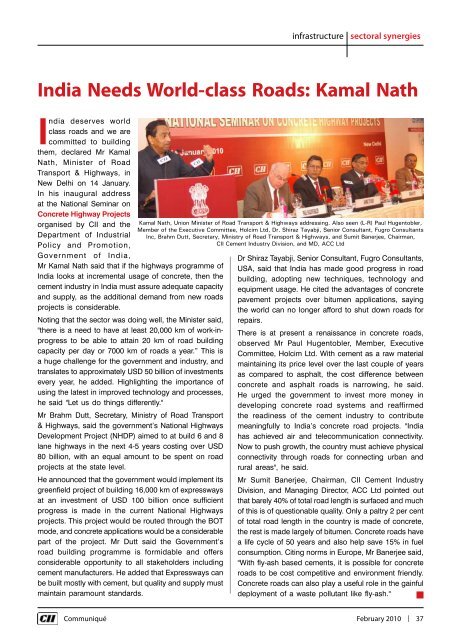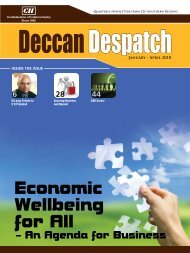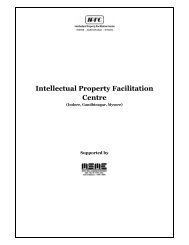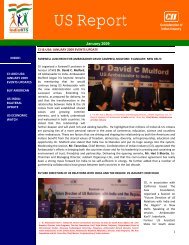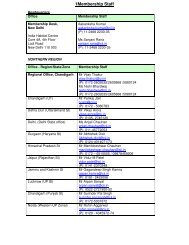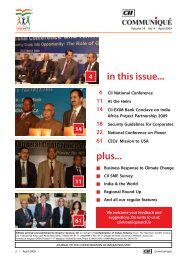CII Communique - February, 2010
CII Communique - February, 2010
CII Communique - February, 2010
Create successful ePaper yourself
Turn your PDF publications into a flip-book with our unique Google optimized e-Paper software.
infrastructure<br />
sectoral synergies<br />
India Needs World-class Roads: Kamal Nath<br />
India deserves world<br />
class roads and we are<br />
committed to building<br />
them, declared Mr Kamal<br />
Nath, Minister of Road<br />
Transport & Highways, in<br />
New Delhi on 14 January.<br />
In his inaugural address<br />
at the National Seminar on<br />
Concrete Highway Projects<br />
organised by <strong>CII</strong> and the<br />
Department of Industrial<br />
Policy and Promotion,<br />
Government of India,<br />
Mr Kamal Nath said that if the highways programme of<br />
India looks at incremental usage of concrete, then the<br />
cement industry in India must assure adequate capacity<br />
and supply, as the additional demand from new roads<br />
projects is considerable.<br />
Noting that the sector was doing well, the Minister said,<br />
"there is a need to have at least 20,000 km of work-inprogress<br />
to be able to attain 20 km of road building<br />
capacity per day or 7000 km of roads a year.” This is<br />
a huge challenge for the government and industry, and<br />
translates to approximately USD 50 billion of investments<br />
every year, he added. Highlighting the importance of<br />
using the latest in improved technology and processes,<br />
he said "Let us do things differently."<br />
Mr Brahm Dutt, Secretary, Ministry of Road Transport<br />
& Highways, said the government’s National Highways<br />
Development Project (NHDP) aimed to at build 6 and 8<br />
lane highways in the next 4-5 years costing over USD<br />
80 billion, with an equal amount to be spent on road<br />
projects at the state level.<br />
He announced that the government would implement its<br />
greenfield project of building 16,000 km of expressways<br />
at an investment of USD 100 billion once sufficient<br />
progress is made in the current National Highways<br />
projects. This project would be routed through the BOT<br />
mode, and concrete applications would be a considerable<br />
part of the project. Mr Dutt said the Government’s<br />
road building programme is formidable and offers<br />
considerable opportunity to all stakeholders including<br />
cement manufacturers. He added that Expressways can<br />
be built mostly with cement, but quality and supply must<br />
maintain paramount standards.<br />
Kamal Nath, Union Minister of Road Transport & Highways addressing. Also seen (L-R) Paul Hugentobler,<br />
Member of the Executive Committee, Holcim Ltd, Dr. Shiraz Tayabji, Senior Consultant, Fugro Consultants<br />
Inc, Brahm Dutt, Secretary, Ministry of Road Transport & Highways, and Sumit Banerjee, Chairman,<br />
<strong>CII</strong> Cement Industry Division, and MD, ACC Ltd<br />
Dr Shiraz Tayabji, Senior Consultant, Fugro Consultants,<br />
USA, said that India has made good progress in road<br />
building, adopting new techniques, technology and<br />
equipment usage. He cited the advantages of concrete<br />
pavement projects over bitumen applications, saying<br />
the world can no longer afford to shut down roads for<br />
repairs.<br />
There is at present a renaissance in concrete roads,<br />
observed Mr Paul Hugentobler, Member, Executive<br />
Committee, Holcim Ltd. With cement as a raw material<br />
maintaining its price level over the last couple of years<br />
as compared to asphalt, the cost difference between<br />
concrete and asphalt roads is narrowing, he said.<br />
He urged the government to invest more money in<br />
developing concrete road systems and reaffirmed<br />
the readiness of the cement industry to contribute<br />
meaningfully to India’s concrete road projects. "India<br />
has achieved air and telecommunication connectivity.<br />
Now to push growth, the country must achieve physical<br />
connectivity through roads for connecting urban and<br />
rural areas", he said.<br />
Mr Sumit Banerjee, Chairman, <strong>CII</strong> Cement Industry<br />
Division, and Managing Director, ACC Ltd pointed out<br />
that barely 40% of total road length is surfaced and much<br />
of this is of questionable quality. Only a paltry 2 per cent<br />
of total road length in the country is made of concrete,<br />
the rest is made largely of bitumen. Concrete roads have<br />
a life cycle of 50 years and also help save 15% in fuel<br />
consumption. Citing norms in Europe, Mr Banerjee said,<br />
"With fly-ash based cements, it is possible for concrete<br />
roads to be cost competitive and environment friendly.<br />
Concrete roads can also play a useful role in the gainful<br />
deployment of a waste pollutant like fly-ash."<br />
Communiqué <strong>February</strong> <strong>2010</strong> | 37


